The MLB season is a long one. With 162 games on the schedule, it requires hard work, dedication, and a commitment to excellence to succeed. Over such an extended period, players may find an increased rate of success or failure by doing things incredibly well or poorly in small bunches, all leading to their cumulative season statistics. Those small bunches can also be called streaks, where repeated success or failure happens over a specific period. A hot streak is one where good things are happening for the player involved, whereas a cold streak is one where bad things are happening.
Why is this important? Understanding that a player is either seeing the ball well at the plate or controlling it better when pitching is crucial for success. Conversely, recognizing that a player is struggling to make contact or show control and command of the strike zone is good to know, too, so that other options can be used. This gives fantasy players an edge to insert someone into or exclude them from their lineup for an added chance of success. After all, the players are human beings and go through success and failure like everyone else. With that in mind, here are some players to monitor based on their recent streaks.
Hot Streaks
This season, Nathaniel Lowe was known for being a talented player over small spurts, but someone who was never able to put together a full season of quality baseball. Last season, he came out of the gate flying but struggled to maintain momentum throughout the year, and it took months to turn things around to salvage a season of some worth. This year seems like a different story, as he’s been able to show that the pedigree with which he was drafted is more of a reality.
While stumbling out of the gate in May, he turned on the jets and was arguably the best hitter in Texas. The key to his success seems to be recognizing pitches, their location in and out of the strike zone, and showing more aggression in attacking pitches that he liked to get after the pitchers he was facing. That change in approach seemed to open the floodgates toward his breakout, and seemingly afterward, his numbers began to skyrocket, making him one of the game’s better players at first base.
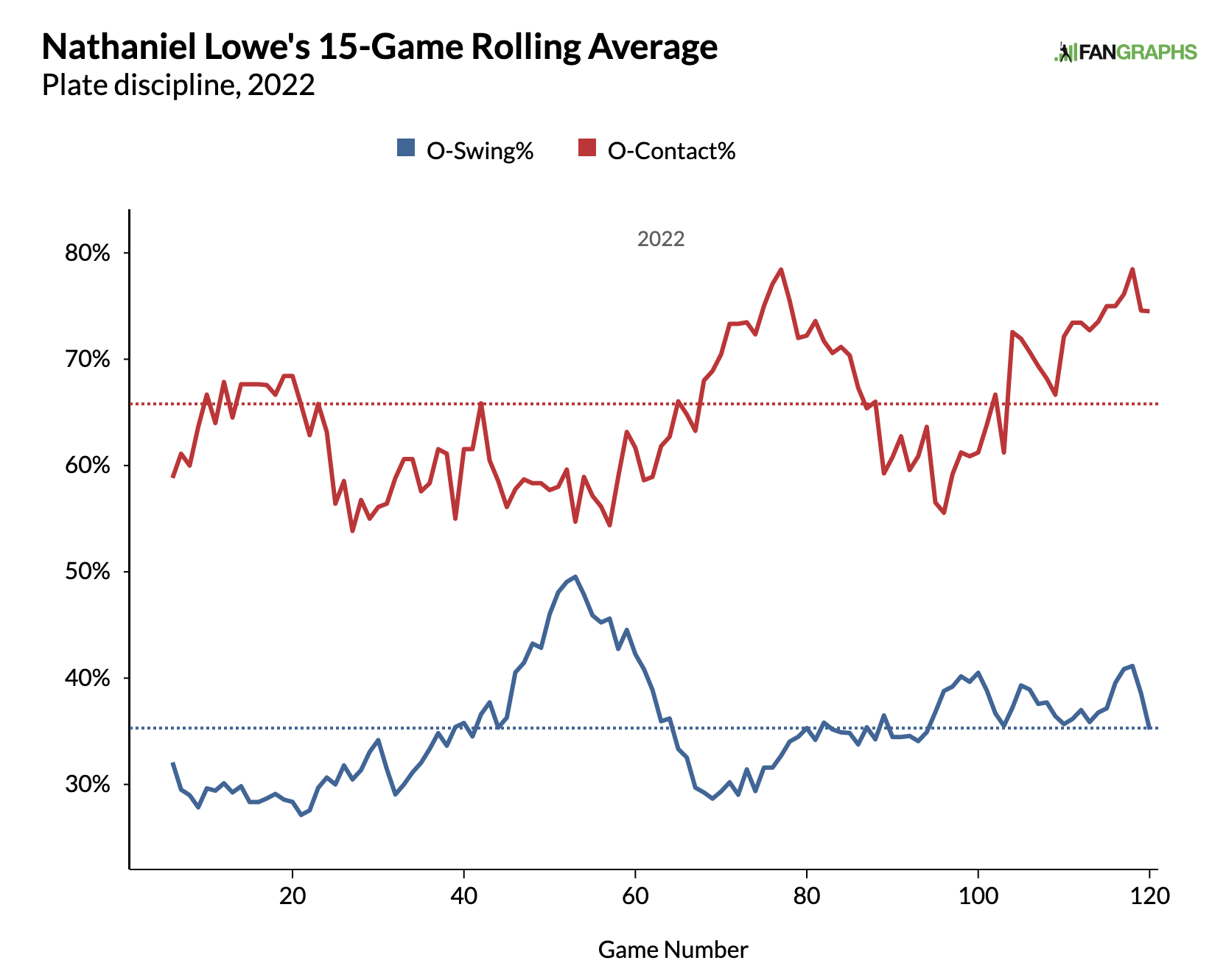
Overall, his aggression has increased power over this last little while, and he is a more consistent force at the plate. Since August 1, he has posted a .392/.449/.639 triple slash line with six home runs and a steal while batting almost daily. His hot streak isn’t just due to a power increase, as he’s been able to get on base and provide the Rangers with increased stability at first base. He’s lowered his ground ball rate and elevated the ball in the air with a raised line drive rate too. Overall, he’s making better contact, and the results have been flourishing.
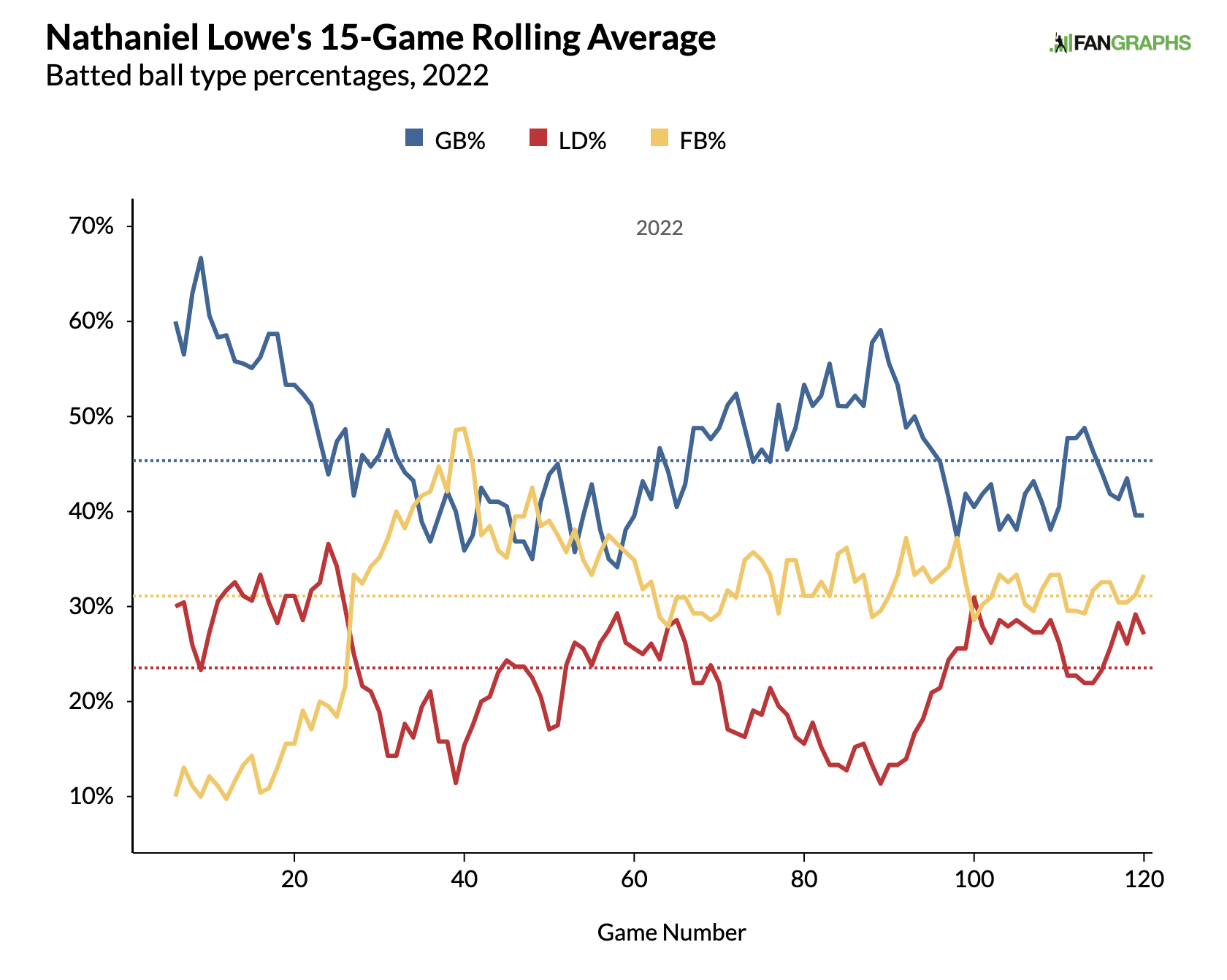
Conclusion: Nathaniel Lowe is having a breakout season sustained through various high points all year. He’s aggressively attacking pitchers and elevating the ball to use his power while putting the ball in play. He has also said he feels more appreciated in Texas and loves playing daily, unlike being a platoon player in Tampa Bay. Over the final stretch of this season, he should continue to get everyday at-bats and help fantasy owners into October.
After a moderately successful beginning to his career last year, Justin Steele came into the 2022 season hoping to maintain a spot in the Cubs’ rotation as they rebuilt for the future. It turns out that he would be given a chance to perform consistently due to injuries surrounding him, and boy, has he ever done that. Steele began the year using three distinct pitches but has since almost eliminated his sinker to the point where it is barely used. The last time he threw it with less consistency (from July 4 onward) was approximately when he started to turn things around this season, and his breakout began to happen.
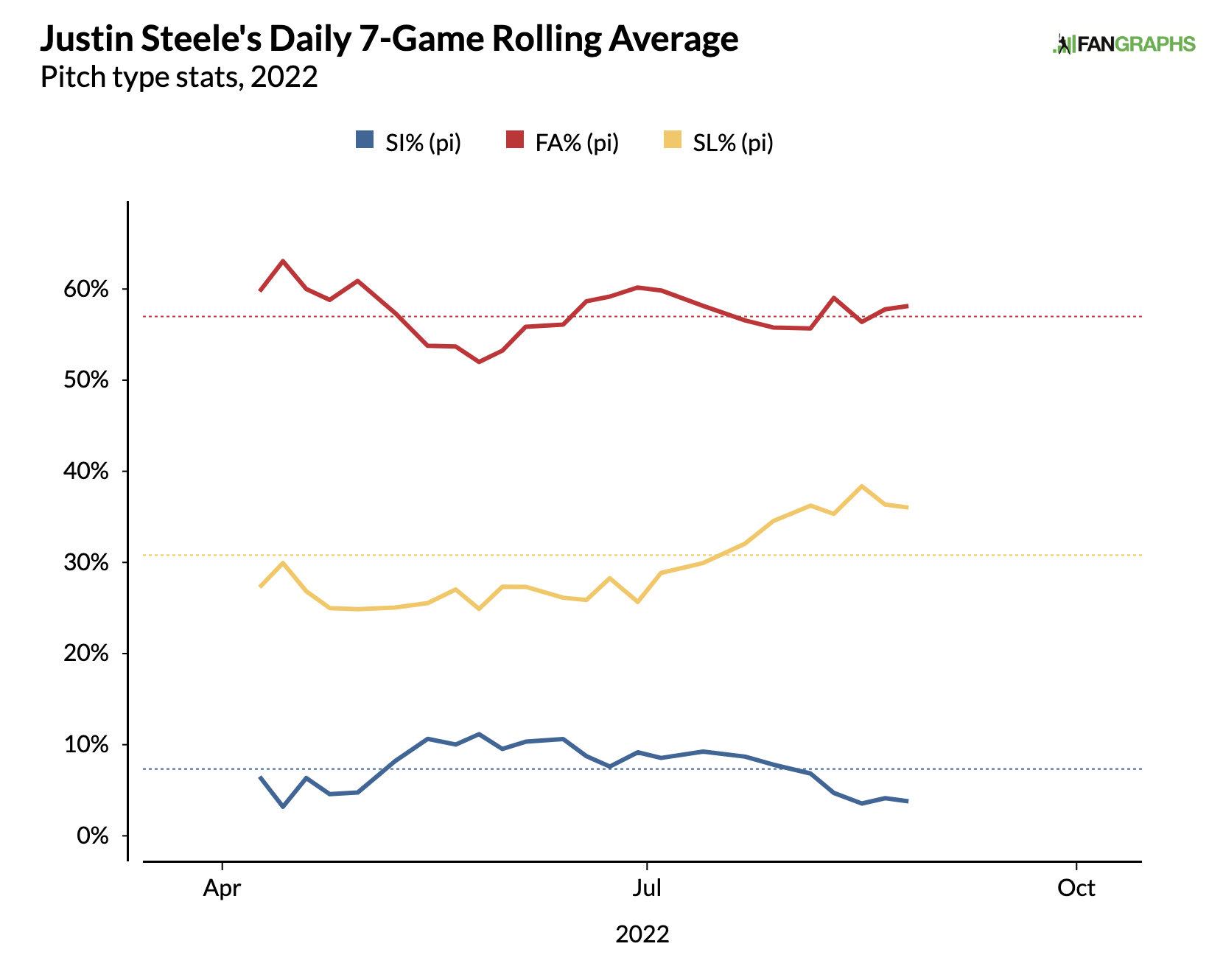
And since then, he has dominated the completion. In seven of his nine starts within that timeframe, he has surrendered one run or fewer. He has four games in which he struck out nine or more batters. While he is suspect of walking batters and giving up hits, it’s encouraging nonetheless, given that he’s able to minimize the damage with an average BABIP, which keeps runs off the board. Overall, his devastating slider is helping him dominate, as it has a .136 batting average against and a 32.7% Whiff Rate.
.@J_Steele21 has an ERA of 1.46 since the start of July.
That’s the BEST in MLB (min. 45 IP) ? pic.twitter.com/2C0wwIXAll
— Marquee Sports Network (@WatchMarquee) August 27, 2022
Conclusion: Justin Steele is someone that should be rostered just about everywhere. He will get a chance to pitch for the Cubs down the stretch and should be able to showcase his talents. While he was pulled on Friday for back pain, there are early reports that it was preventive, but it’s something to monitor. That said, Justin Steele looks to be an essential piece for the Cubs and has performed as such for the rest of the year.
Cold Streaks
Josh Bell had a career-best season when he was a part of the Washington Nationals earlier this year. The first baseman hit fourteen home runs and compiled a .301/.384/.493 triple slash line and was an important piece of their everyday lineup. After being traded to the Padres at the deadline, he has struggled to resemble anything close to this sort of production, as he slumped at the plate for most of his time there. Since arriving in San Diego, Bell has gone ice cold, posting a .177/.301/.304 triple slash line and all but eliminated any power from his output.
Looking at his numbers, he has maintained a similar level of patience at the plate, posting excellent walk and strikeout rates, so his approach there isn’t a problem.
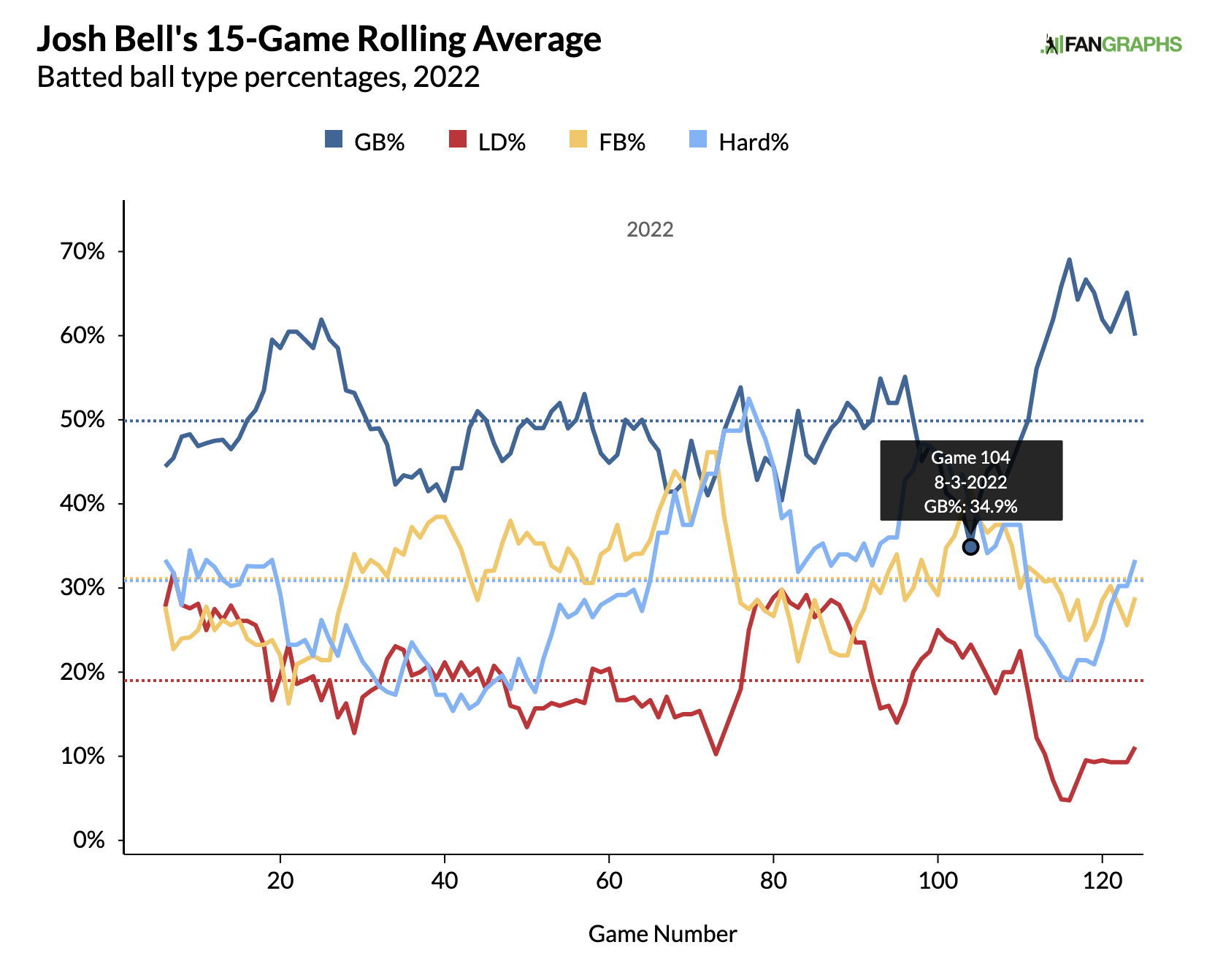
There’s a lot to unpack with this graph, so here goes. Bell’s tenure with the Padres began on August 3, hence the label there. Since his arrival, he seems to be hitting an incredible amount of ground balls and eliminating much elevation in the ball. In fact, his highest ground ball rates and lowest line drive rates of the season seem to have taken place while in San Diego. As someone who will not have speed on his side, Josh Bell needs to put the ball in the air and hit it hard to get on base. This could have been for a few reasons, one being a human. Moving from one team to another can be pressure-filled and nerve-wracking, and he may have been trying too hard to do things here. He’s been working hard off the field, and the results may start to pay off.
Josh Bell felt he found something working in the batting cage earlier today. “Hopefully so,” he said before the game. “The results will tell.” A few hours later, he hit his first home run as a Padre.
— Dennis Lin (@dennistlin) August 21, 2022
Conclusion: Josh Bell is a vital piece of the puzzle for the Padres as they push for a playoff spot. He is no stranger to long and elongated struggles, as evidenced by his 2019 second-half collapse from stardom. Nonetheless, he seems to have grown and developed since then, leading one to believe that he will turn things around in September. Though nothing is set in stone, it’s still important to be aware of his struggles and that they may not be over, despite his back-to-back home runs earlier this week.
The Miami Marlins are a team whose strength is pitching, and Pablo López has traditionally been a big reason for that. When healthy, he has been a stalwart in their rotation, providing efficiency and dependability for a team that struggles to score runs. Still, the most crucial part of that sentence is understanding the healthy part of it, as he has struggled with right shoulder problems for most of his career. As such, he had never thrown for more than 111.1 innings in a season entering 2022, so the amount of reliability was in question.
Almost like clockwork, he began to struggle soon after he surpassed his career totals in innings pitched. He has since thrown 24 innings and compiled a 6.75 ERA while striking out eighteen batters and walking seven. It’s been rough. Since then, his pitches haven’t all been as effective as before.
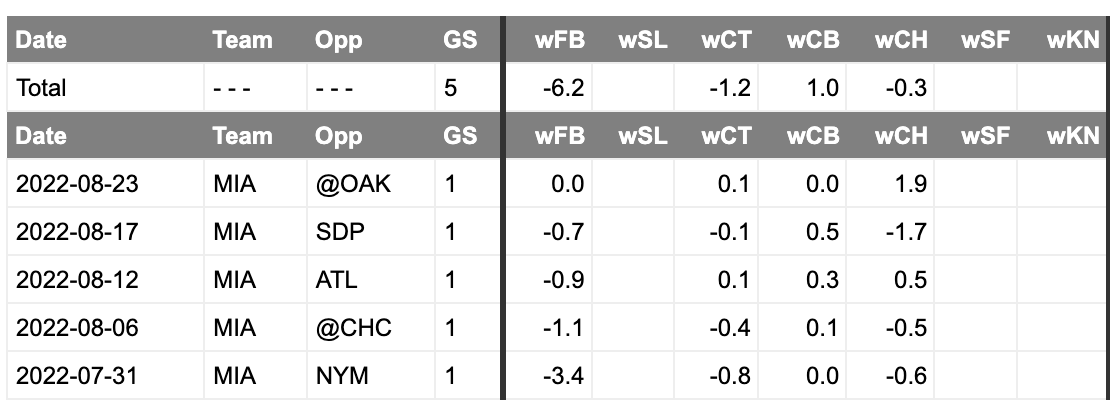
Looking at the pitch value chart, it’s crucial to know that any pitch that scores a zero demonstrates average performance. Any number above zero means that the pitch was below average, while anything above zero means that the pitch was above average—the more significant the difference from zero, the stronger or weaker the pitch produced in that game. As we examine the values, the fastball seems to be getting battered in almost every outing, with the changeup being his second worse pitch. What’s interesting here is that his curveball produced quite decently over this stretch. Digging deeper, there may be a different reason for his struggles, as it appears that his pitch mix is changing. He is tinkering with his curveball, changeup, and cutter usage.

It’s interesting that perhaps Pablo López, who typically throws five pitches with some regularity, might be trying to enhance that elusive dominant third pitch further, making it a more effective part of his repertoire. The curveball has quietly been an excellent weapon for him, as it has a .193 batting average against hitters this season, and making it the third piece to his pitch mix might make him a dangerous weapon in the future. He may also be phasing out his cutter, which would help him focus more on throwing what’s most effective in the future.
Conclusion: While it’s been a frustrating ride for fantasy owners this season, Pablo López is still a very talented pitcher. While some of his declines could be due to stretching himself out over a significant innings boost, digging deeper would indicate that it’s because he’s working on a third pitch. While bumps in the road to growth are expected, Lopez might still be someone to avoid for the rest of the season while he figures things out. There’s also a chance he gets shut down or skipped in the rotation to protect an important component of the Marlins’ future.
Featured Image by Michael Packard
